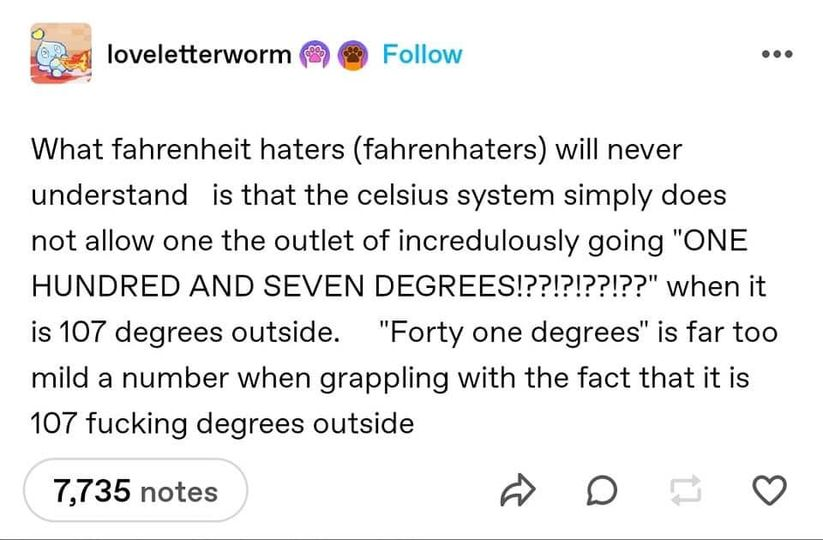this post was submitted on 09 Sep 2024
1236 points (92.3% liked)
Science Memes
10950 readers
1960 users here now
Welcome to c/science_memes @ Mander.xyz!
A place for majestic STEMLORD peacocking, as well as memes about the realities of working in a lab.

Rules
- Don't throw mud. Behave like an intellectual and remember the human.
- Keep it rooted (on topic).
- No spam.
- Infographics welcome, get schooled.
This is a science community. We use the Dawkins definition of meme.
Research Committee
Other Mander Communities
Science and Research
Biology and Life Sciences
- [email protected]
- [email protected]
- [email protected]
- [email protected]
- [email protected]
- [email protected]
- [email protected]
- [email protected]
- [email protected]
- [email protected]
- [email protected]
- [email protected]
- [email protected]
- [email protected]
- [email protected]
- [email protected]
- [email protected]
- [email protected]
- [email protected]
- [email protected]
- [email protected]
- [email protected]
- [email protected]
- [email protected]
- !reptiles and [email protected]
Physical Sciences
- [email protected]
- [email protected]
- [email protected]
- [email protected]
- [email protected]
- [email protected]
- [email protected]
- [email protected]
- [email protected]
Humanities and Social Sciences
Practical and Applied Sciences
- !exercise-and [email protected]
- [email protected]
- !self [email protected]
- [email protected]
- [email protected]
- [email protected]
Memes
Miscellaneous
founded 2 years ago
MODERATORS
you are viewing a single comment's thread
view the rest of the comments
view the rest of the comments

I present the temperature scale that I made up- the Human Scale (H°)
I thought about the Fahrenheit vs Celsius debate, and I think both have practical uses, however I think combined they could make a very practical scale.
Fahrenheit: while my American sensibilities agree that 100° is a good marker for what % of my patience is used up to cut a bitch, I think a similar place would be the average human body temperature. For this reason, 100°H = 98.6°F . It's not a perfect match, but it can still give us the satisfaction of "IT'S 100°!?" while having practical implications for medical uses "your body temperature is 102°, 2° warmer than average".
Celsius: I think this scale makes a ton of sense for colder temperatures. When the thermometer reads 0°, that's when you can expect snow. For this reason, 0°H = 0°C.
The conversation rates are:
H = (F-32) × 1.5
H= C × 2.7
More precise is
H = (F-32) × 1.501501501...
H = C × 2.7027027027...
While using the freezing point of water and the average human body temperature seem like inconsistent and arbitrary benchmarks, my goal is less about consistency and more about practicality for everyday use.
Now watch this scale grow as big as Esperanto.
I believe the Fahrenheit scale was originally set up for 100° to be human body temperature. We're just built colder now I guess? I had to look up what zero was and apparently he originally set it at the coldest the air had ever been around his village, but later had to standardize it and so cooked up some brine that froze at 0°.
I would propose that 100 should be calibrated around the wet bulb temperature, which I think is around 105°F but varies with humidity. That's the temperature where sweating doesn't cool you off any more, so any temperature 100 or more is deadly to most people. I like 0 being freezing for water, seems sensible and is also a good "prolonged exposure to this or lower will kill you" cutoff point.
I heard it was supposed to be human body temperature, but they used horse body temperature instead because it was close to human body temperature but more... stable.
Straight to jail with you